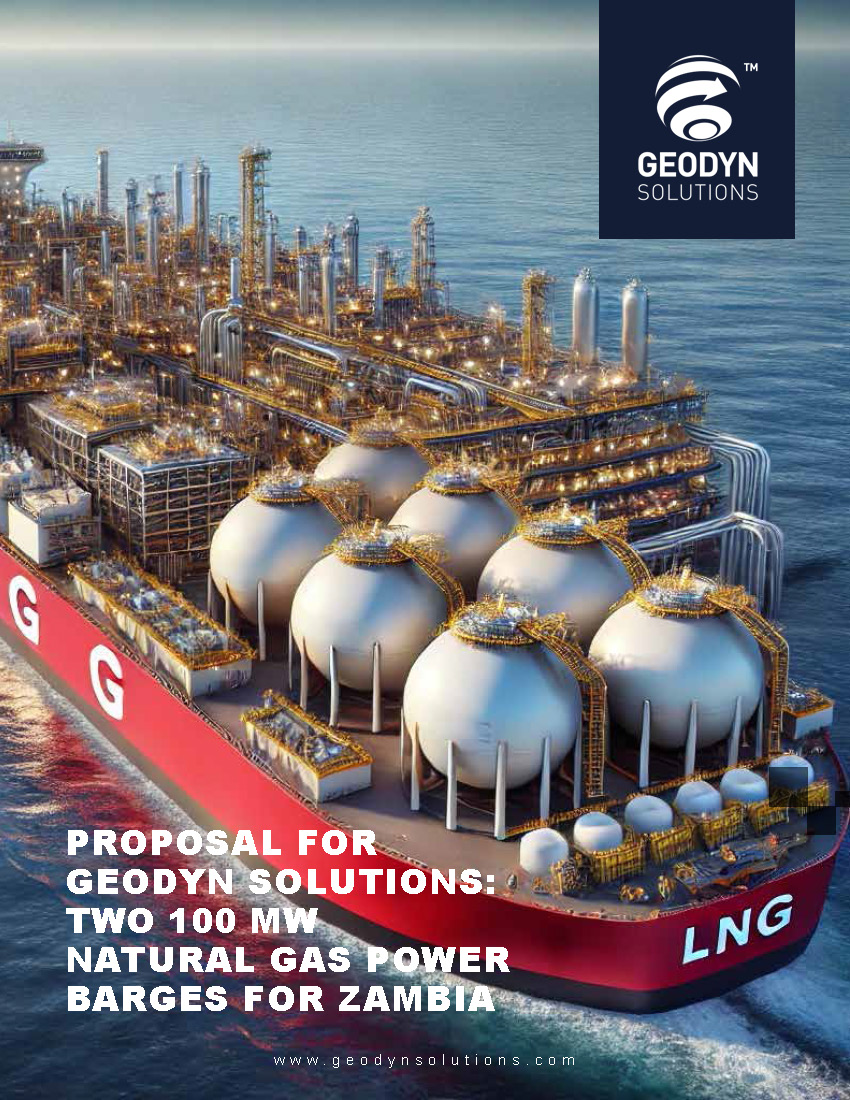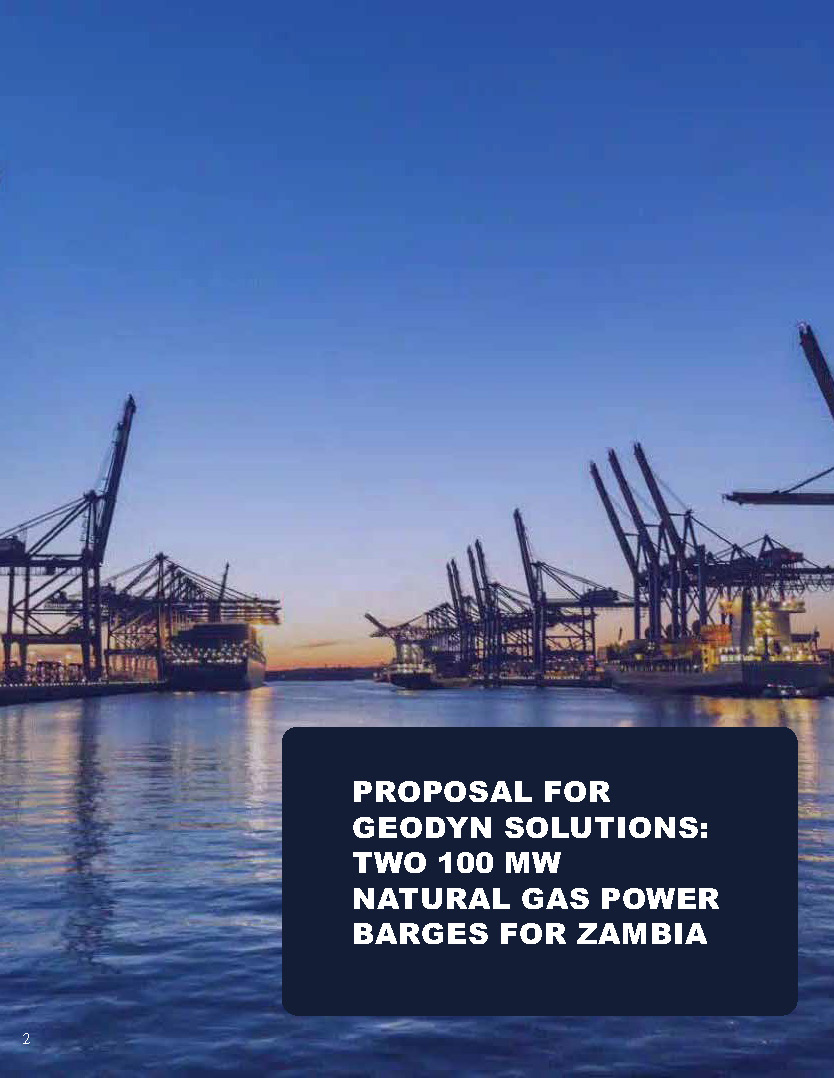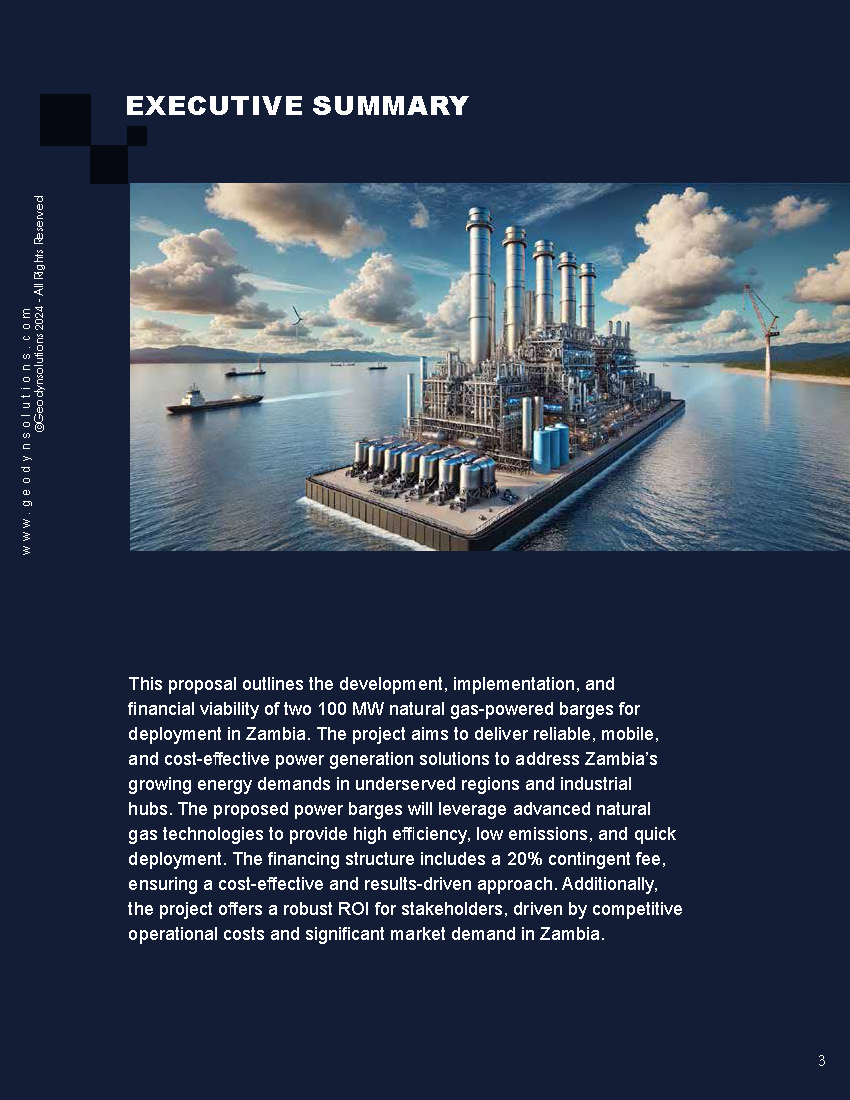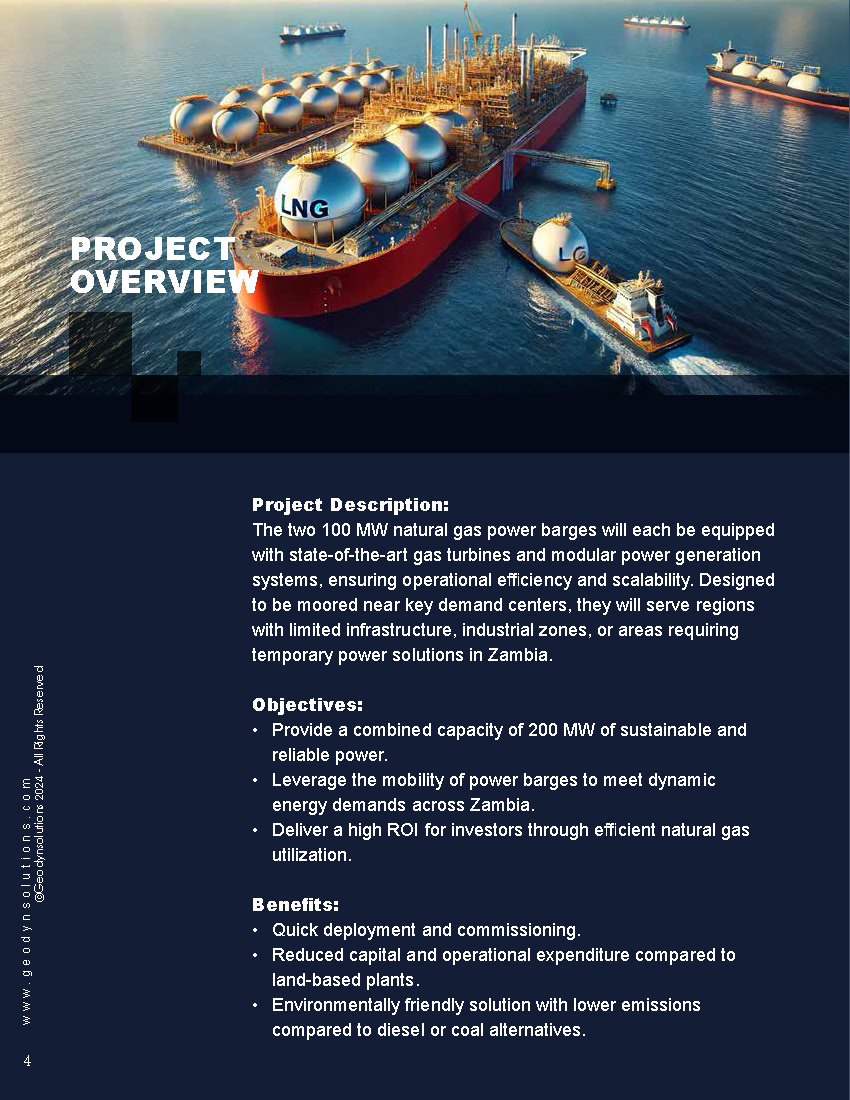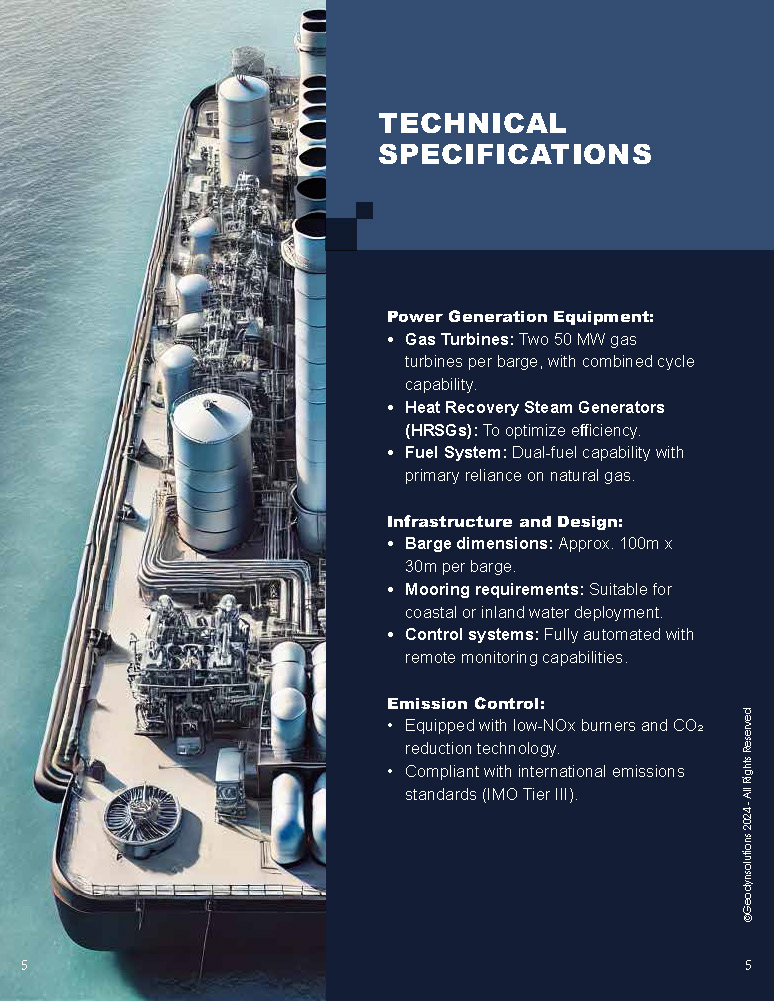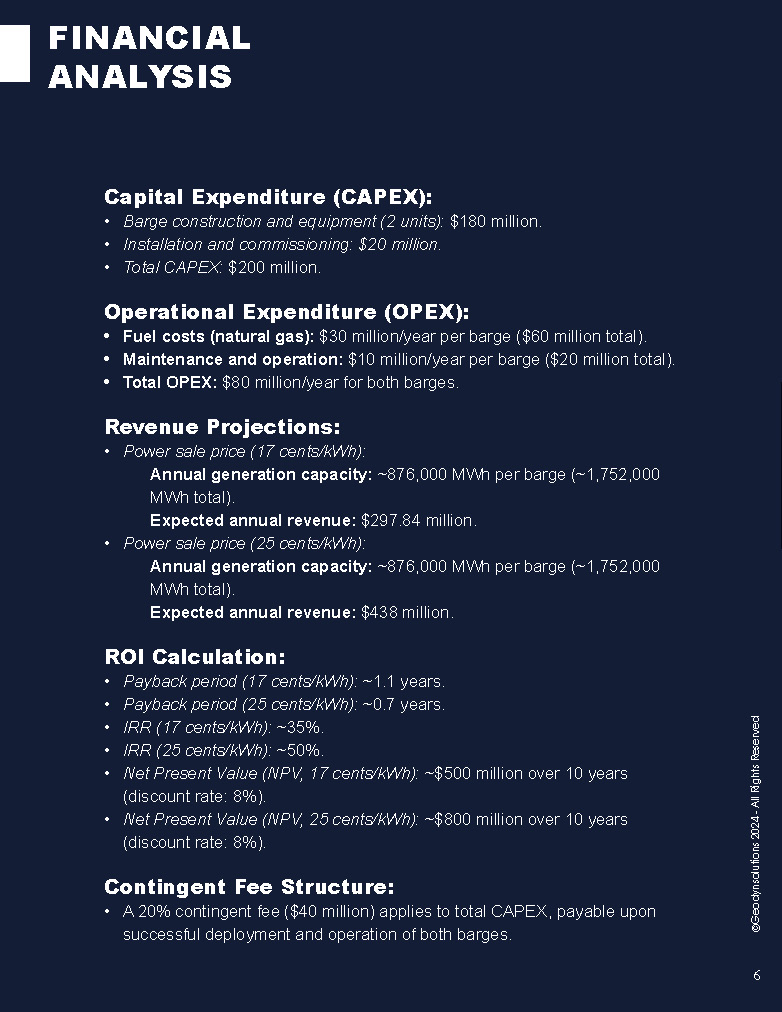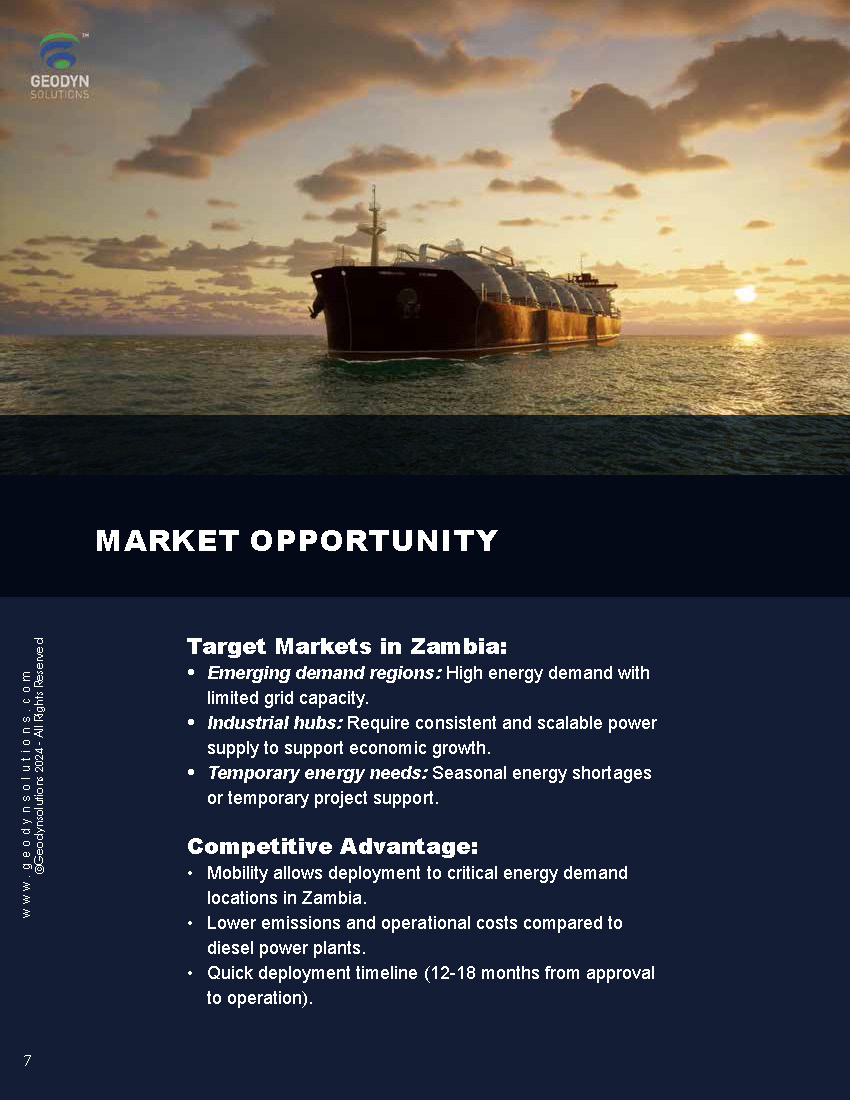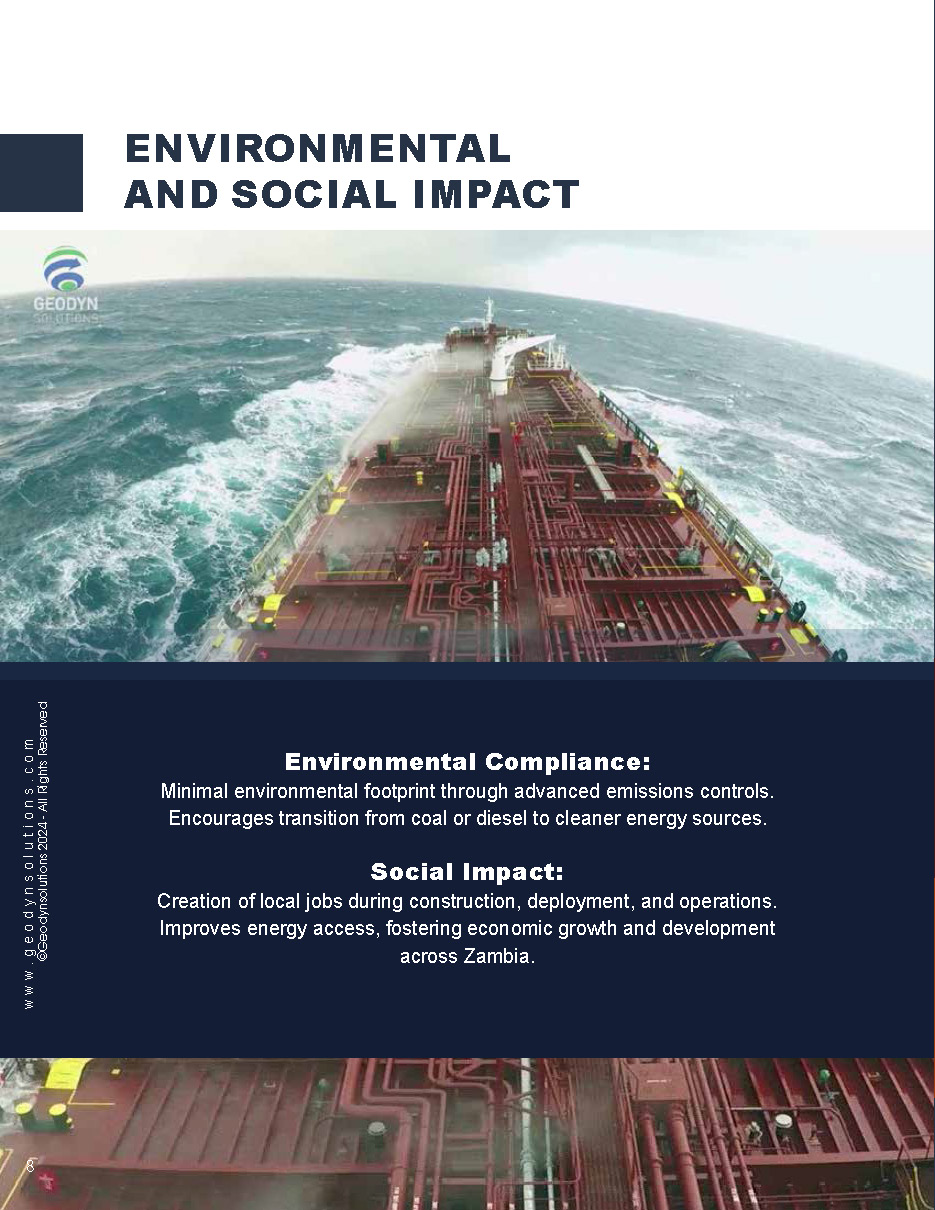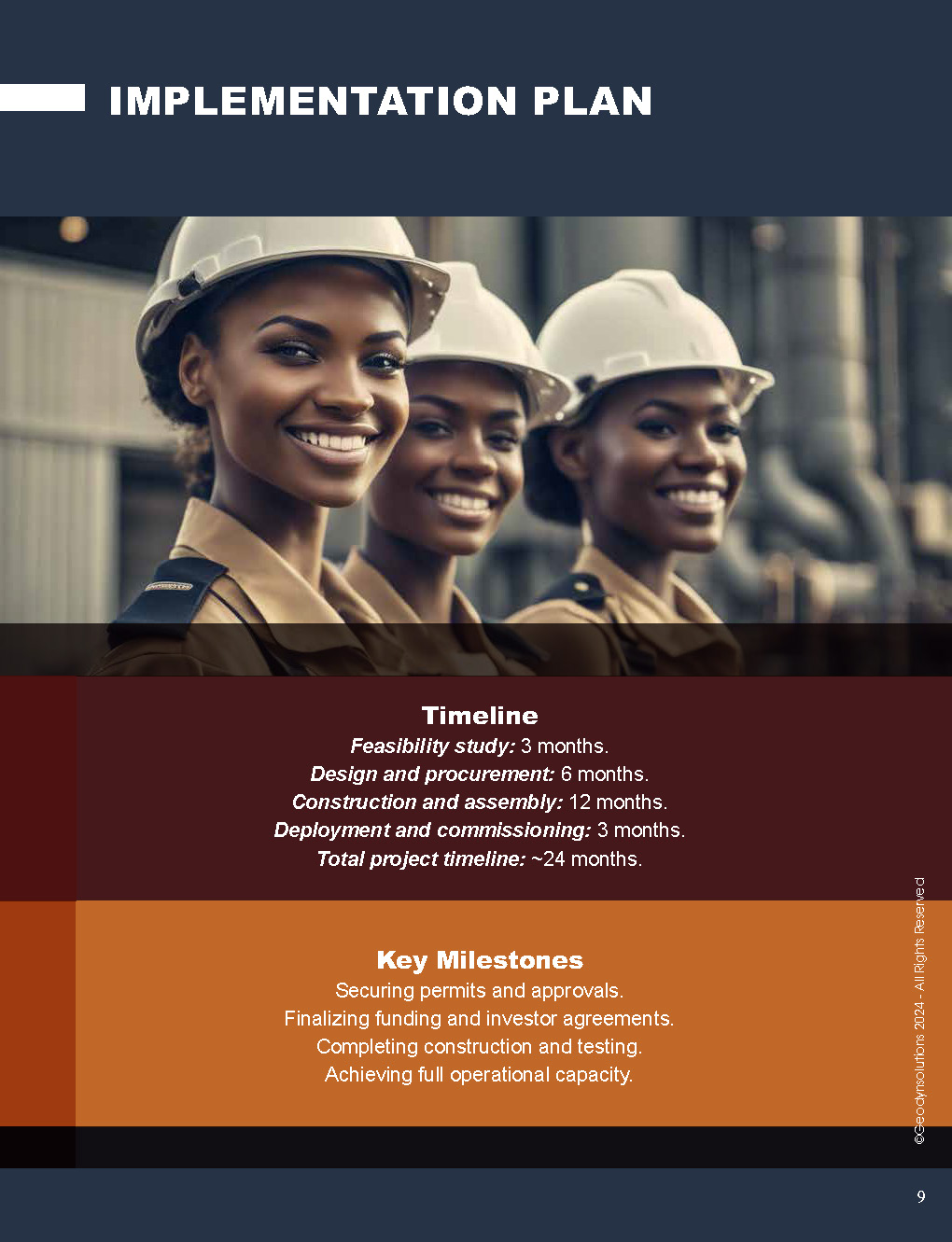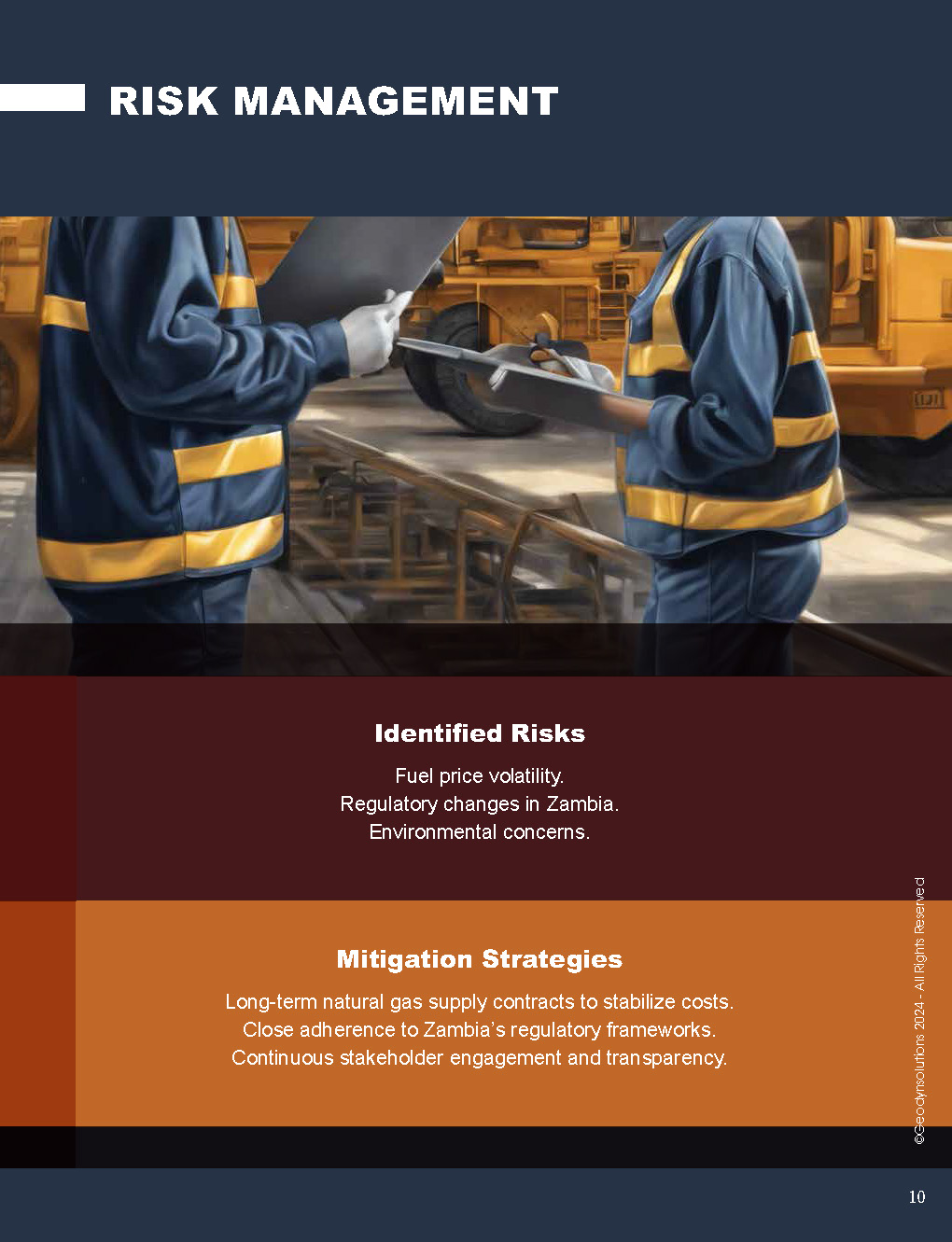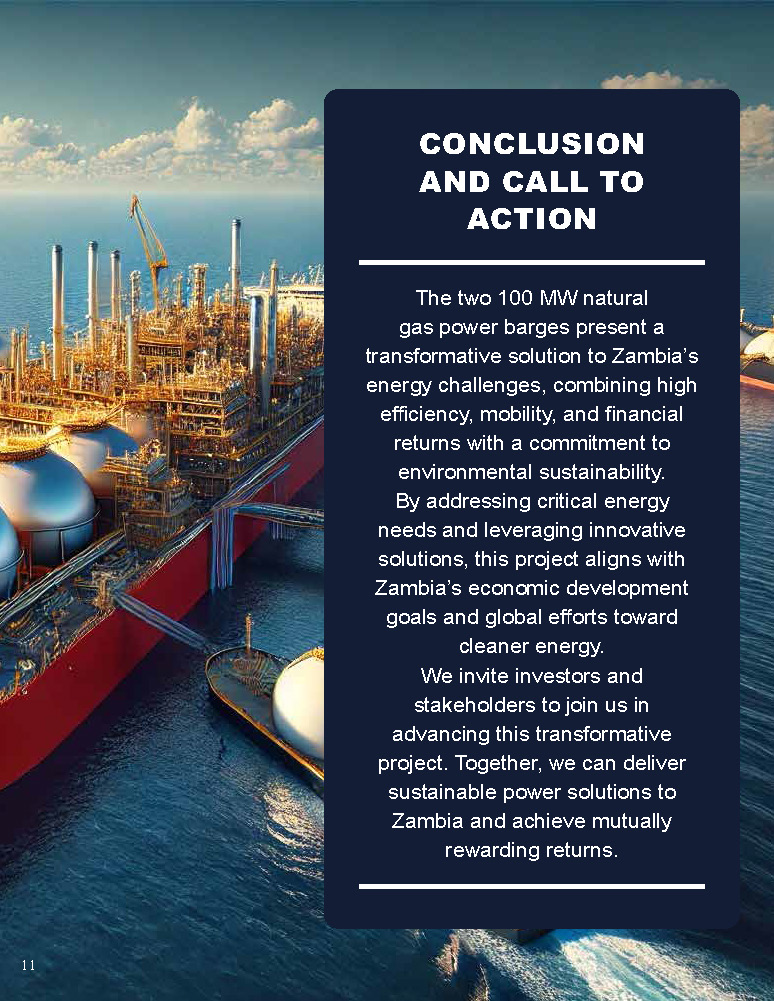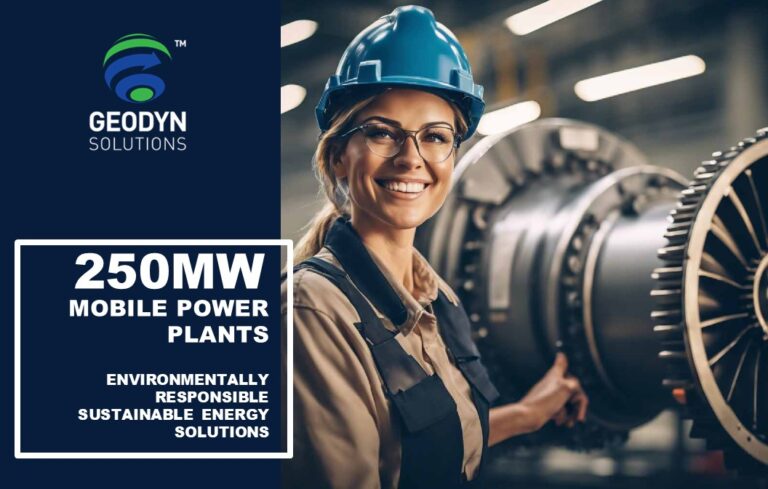Proposal for Geodyn Solutions: Two 100 MW Natural Gas Power Barges for Zambia
Executive Summary: This proposal outlines the development, implementation, and financial viability of two 100 MW natural gas-powered barges for deployment in Zambia. The project aims to deliver reliable, mobile, and cost-effective power generation solutions to address Zambia’s growing energy demands in underserved regions and industrial hubs. The proposed power barges will leverage advanced natural gas technologies to provide high efficiency, low emissions, and quick deployment. The financing structure includes a 20% contingent fee, ensuring a cost-effective and results-driven approach. Additionally, the project offers a robust ROI for stakeholders, driven by competitive operational costs and significant market demand in Zambia.
1. Project Overview:
1.1 Project Description: The two 100 MW natural gas power barges will each be equipped with state-of-the-art gas turbines and modular power generation systems, ensuring operational efficiency and scalability. Designed to be moored near key demand centers, they will serve regions with limited infrastructure, industrial zones, or areas requiring temporary power solutions in Zambia.
1.2 Objectives:
- Provide a combined capacity of 200 MW of sustainable and reliable power.
- Leverage the mobility of power barges to meet dynamic energy demands across Zambia.
- Deliver a high ROI for investors through efficient natural gas utilization.
1.3 Benefits:
- Quick deployment and commissioning.
- Reduced capital and operational expenditure compared to land-based plants.
- Environmentally friendly solution with lower emissions compared to diesel or coal alternatives.
2. Technical Specifications:
2.1 Power Generation Equipment:
- Gas Turbines: Two 50 MW gas turbines per barge, with combined cycle capability.
- Heat Recovery Steam Generators (HRSGs): To optimize efficiency.
- Fuel System: Dual-fuel capability with primary reliance on natural gas.
2.2 Infrastructure and Design:
- Barge dimensions: Approx. 100m x 30m per barge.
- Mooring requirements: Suitable for coastal or inland water deployment.
- Control systems: Fully automated with remote monitoring capabilities.
2.3 Emission Control:
- Equipped with low-NOx burners and CO2 reduction technology.
- Compliant with international emissions standards (IMO Tier III).
3. Financial Analysis:
3.1 Capital Expenditure (CAPEX):
- Barge construction and equipment (2 units): $180 million.
- Installation and commissioning: $20 million.
- Total CAPEX: $200 million.
3.2 Operational Expenditure (OPEX):
- Fuel costs (natural gas): $30 million/year per barge ($60 million total).
- Maintenance and operation: $10 million/year per barge ($20 million total).
- Total OPEX: $80 million/year for both barges.
3.3 Revenue Projections:
- Power sale price (17 cents/kWh):
- Annual generation capacity: ~876,000 MWh per barge (~1,752,000 MWh total).
- Expected annual revenue: $297.84 million.
- Power sale price (25 cents/kWh):
- Annual generation capacity: ~876,000 MWh per barge (~1,752,000 MWh total).
- Expected annual revenue: $438 million.
3.4 ROI Calculation:
- Payback period (17 cents/kWh): ~1.1 years.
- Payback period (25 cents/kWh): ~0.7 years.
- IRR (17 cents/kWh): ~35%.
- IRR (25 cents/kWh): ~50%.
- Net Present Value (NPV, 17 cents/kWh): ~$500 million over 10 years (discount rate: 8%).
- Net Present Value (NPV, 25 cents/kWh): ~$800 million over 10 years (discount rate: 8%).
3.5 Contingent Fee Structure:
- A 20% contingent fee ($40 million) applies to total CAPEX, payable upon successful deployment and operation of both barges.
4. Market Opportunity:
4.1 Target Markets in Zambia:
- Emerging demand regions: High energy demand with limited grid capacity.
- Industrial hubs: Require consistent and scalable power supply to support economic growth.
- Temporary energy needs: Seasonal energy shortages or temporary project support.
4.2 Competitive Advantage:
- Mobility allows deployment to critical energy demand locations in Zambia.
- Lower emissions and operational costs compared to diesel power plants.
- Quick deployment timeline (12-18 months from approval to operation).
5. Environmental and Social Impact:
5.1 Environmental Compliance:
- Minimal environmental footprint through advanced emissions controls.
- Encourages transition from coal or diesel to cleaner energy sources.
5.2 Social Impact:
- Creation of local jobs during construction, deployment, and operations.
- Improves energy access, fostering economic growth and development across Zambia.
6. Implementation Plan:
6.1 Timeline:
- Feasibility study: 3 months.
- Design and procurement: 6 months.
- Construction and assembly: 12 months.
- Deployment and commissioning: 3 months.
- Total project timeline: ~24 months.
6.2 Key Milestones:
- Securing permits and approvals.
- Finalizing funding and investor agreements.
- Completing construction and testing.
- Achieving full operational capacity.
7. Risk Management:
7.1 Identified Risks:
- Fuel price volatility.
- Regulatory changes in Zambia.
- Environmental concerns.
7.2 Mitigation Strategies:
- Long-term natural gas supply contracts to stabilize costs.
- Close adherence to Zambia’s regulatory frameworks.
- Continuous stakeholder engagement and transparency.
8. Conclusion and Call to Action:
The two 100 MW natural gas power barges present a transformative solution to Zambia’s energy challenges, combining high efficiency, mobility, and financial returns with a commitment to environmental sustainability. By addressing critical energy needs and leveraging innovative solutions, this project aligns with Zambia’s economic development goals and global efforts toward cleaner energy.
We invite investors and stakeholders to join us in advancing this transformative project. Together, we can deliver sustainable power solutions to Zambia and achieve mutually rewarding returns.
